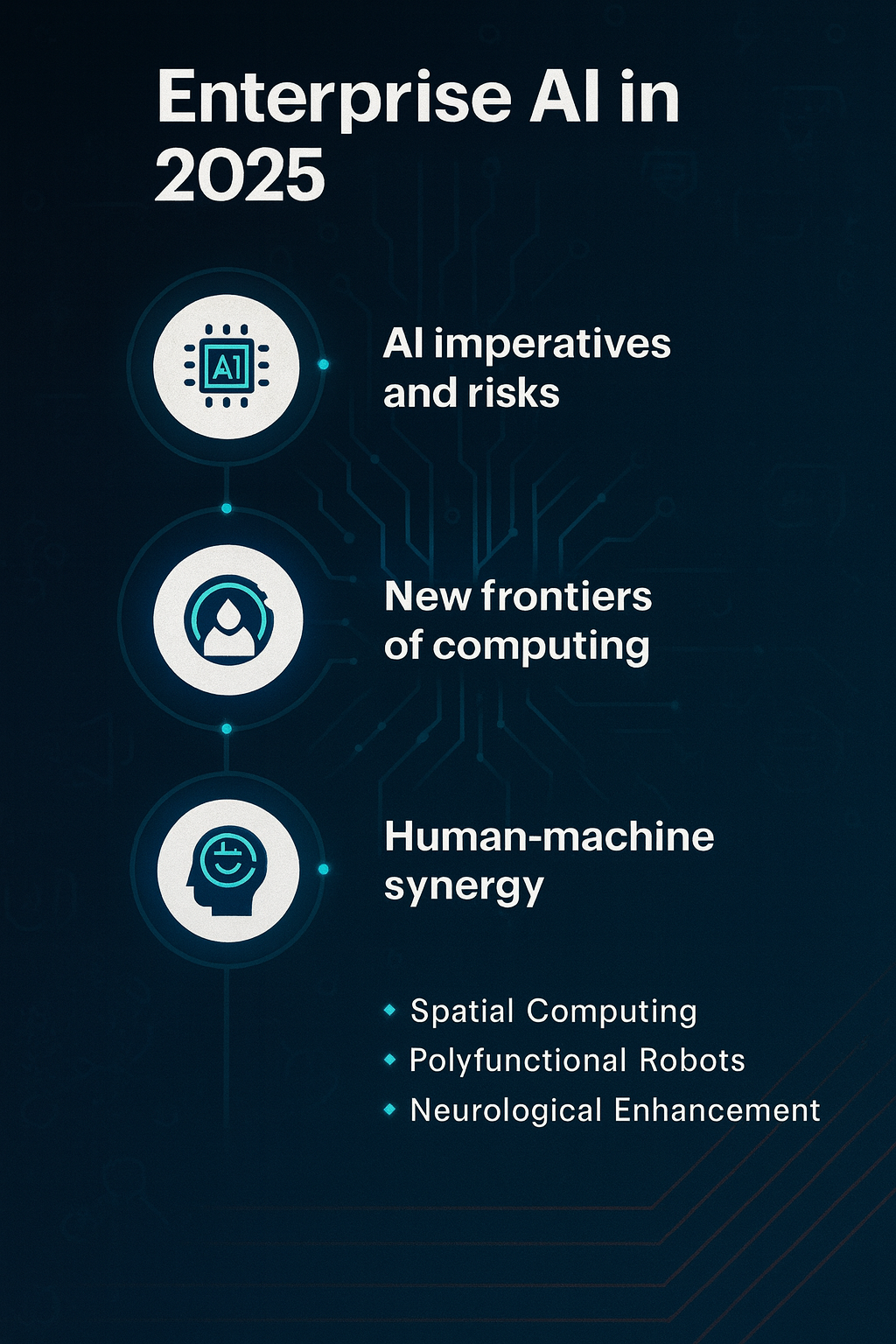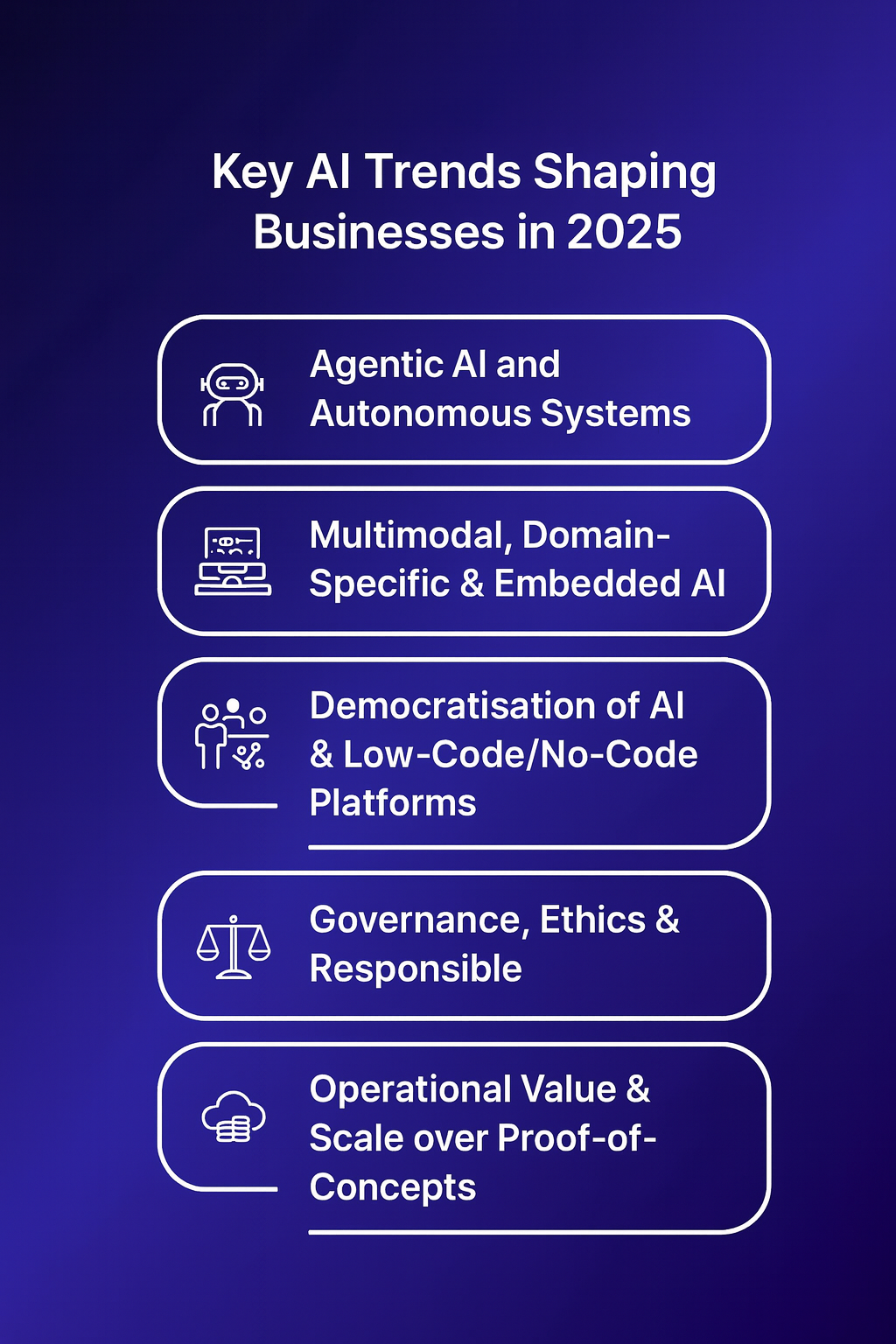


.png)
.png)
From the early days of rule-based automation to today’s generative models and agentic systems, Artificial Intelligence (AI) has moved from “interesting experiment” to business imperative. As the team at Proso AI noted back in 2021, AI was already “on the verge” of revolutionising many sectors. Fast forward to 2025—and that future is here. Yet for many organisations, the question is not if they will use AI, but how well.

This blog explores the major enterprise-AI trends that matter now, the key risks and barriers, and what you as a leader should prioritise to harness value rather than hype.
AI has reached a point where it’s no longer purely research-lab work; companies are embedding it into operations, products and business models. For example:
For enterprises—especially those with large data volumes, complex workflows and evolving digital-business models—this means a strategic choice: treat AI as a novelty, or treat it as a core business capability. The latter will separate the winners from the also-rans.

With “agentic AI” (systems that act autonomously, adaptively and take decisions) gaining traction, organisations are moving beyond simply issuing “recommendations” to enabling machines to manage workflows.
These systems are becoming relevant in customer service, operations, logistics, and even decision-support in regulated industries.
The era of simple text-based chatbots is giving way to multimodal systems (processing text, voice, image, video) and domain-specific AI models tuned to particular industries.
For enterprise leaders, this means AI expects to be more than a generic “tool”—it needs to integrate with your domain, data, and workflows.
AI is becoming accessible to non-data-scientists via low-code / no-code platforms, enabling business users to build, test and deploy AI solutions more rapidly.
For your organisation, this means broader responsibility across teams—not just a central AI team.
As AI enters more critical business functions, issues around transparency, bias, model risk, data privacy and regulatory compliance are front and centre.
If you don’t address governance and ethics proactively, your AI ambitions may be hindered or derailed.
The hype around AI has given way to pragmatic questions: “Can we scale this?” “What measurable business value will this deliver?” Research shows that only a small proportion of companies have moved from POC to enterprise-wide value creation.
This emphasises the need for clear business cases, measurable KPIs and alignment with strategy.
Building for AI isn’t just about models—it’s about data pipelines, compute infrastructure (including edge), governance, integration with legacy systems, and cross-platform interoperability.
For enterprises with complex systems (e.g., combining CRM, HCM, ERP, supply chain) this is a major consideration.
If you are in a leadership role (IT/CTO, business unit head, transformation office), here are the direct implications:
Start by identifying critical pain-points or opportunities where AI can deliver value (e.g., in customer service, supply-chain optimisation, predictive maintenance, talent analytics). Ensure the use-case aligns with your organisation’s strategic objectives.
Ensure you have access to clean, trustworthy data, scalable infrastructure (cloud/edge), integration capabilities with existing systems, and governance mechanisms to manage risk.
Treat AI implementation as transformation, not just a technology rollout. This means:
Pilot projects are fine—but design them with scale in mind. That means: repeatable architecture, clear business metrics, and integration into core systems (CRM, ERP, etc.). Avoid the “sandbox trap” of many AI initiatives.
Measure the outcomes of your AI initiatives (ROI, productivity uplift, user adoption). Implement governance frameworks for model lifecycle (bias, drift, transparency) and evolve accordingly.
In the medium term (2026-2028) you should anticipate:
AI is no longer an optional technology trend—it's a fundamental driver of enterprise competitiveness. For leaders working within large, complex organisations (especially those using enterprise platforms like Salesforce, Oracle or Workday), the imperative is clear: move beyond experiments, embed AI as a capability, invest in infrastructure, govern responsibly, and align with business strategy.
As Proso AI’s 2021 article put it: “AI is transforming every walk of life… the world is on the cusp of revolutionizing many sectors through artificial intelligence and data analytics.” Today, that cusp is behind us. The question now is: will your organisation lead the transformation, or be transformed by it?